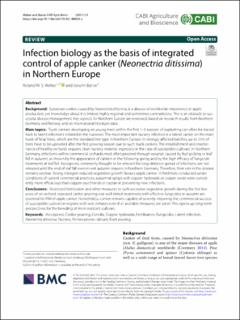| dc.description.abstract | Background: European canker, caused by Neonectria ditissima, is a disease of worldwide importance in apple production, yet knowledge about it is limited, highly regional and sometimes contradictory. This is an obstacle to successful disease management. Key aspects for Northern Europe are reviewed, based on research results from Northern Germany and Norway and on international literature data. Main topics: Trunk cankers developing on young trees within the frst 1–3 seasons of explanting can often be traced back to latent infections initiated in the nurseries. The most important nursery infection is a lateral canker on the main trunk of ‘knip’ trees, which are the standard tree type in Northern Europe. In strongly afected batches, up to 25% of trees have to be uprooted after the frst growing season due to such trunk cankers. The establishment and maintenance of healthy orchards requires clean nursery material, especially in the case of susceptible cultivars. In Northern Germany, infections within commercial orchards most often proceed through wounds caused by fruit picking or leaf fall in autumn, as shown by the appearance of cankers in the following spring and by the high efcacy of fungicide treatments at leaf fall. Ascospores, commonly thought to be relevant for long-distance spread of infections, are not released until the end of leaf fall even in wet autumn seasons in Northern Germany. Therefore, their role in the disease remains unclear. Strong nitrogen-induced vegetative growth favours apple canker. In feld trials conducted under conditions of current commercial practices, autumnal sprays with copper hydroxide or copper oxide were consistently more efcacious than copper oxychloride or captan in preventing new infections. Conclusions: Restricted fertilisation and other measures to curb excessive vegetative growth during the frst few years of an orchard, repeated canker pruning and well-timed treatments with efective fungicides in autumn are essential for IPM of apple canker. Nonetheless, canker remains capable of severely impairing the commercial success of susceptible cultivars in regions with wet climates even if all available measures are taken. This opens up long-term perspectives for the breeding of more resistant cultivars. Keywords: Ascospores, Canker pruning, Conidia, Copper hydroxide, Fertilisation, Fungicides, Latent infection, Neonectria ditissima, Nursery, Prohexadione calcium, Root pruning | en_US |

